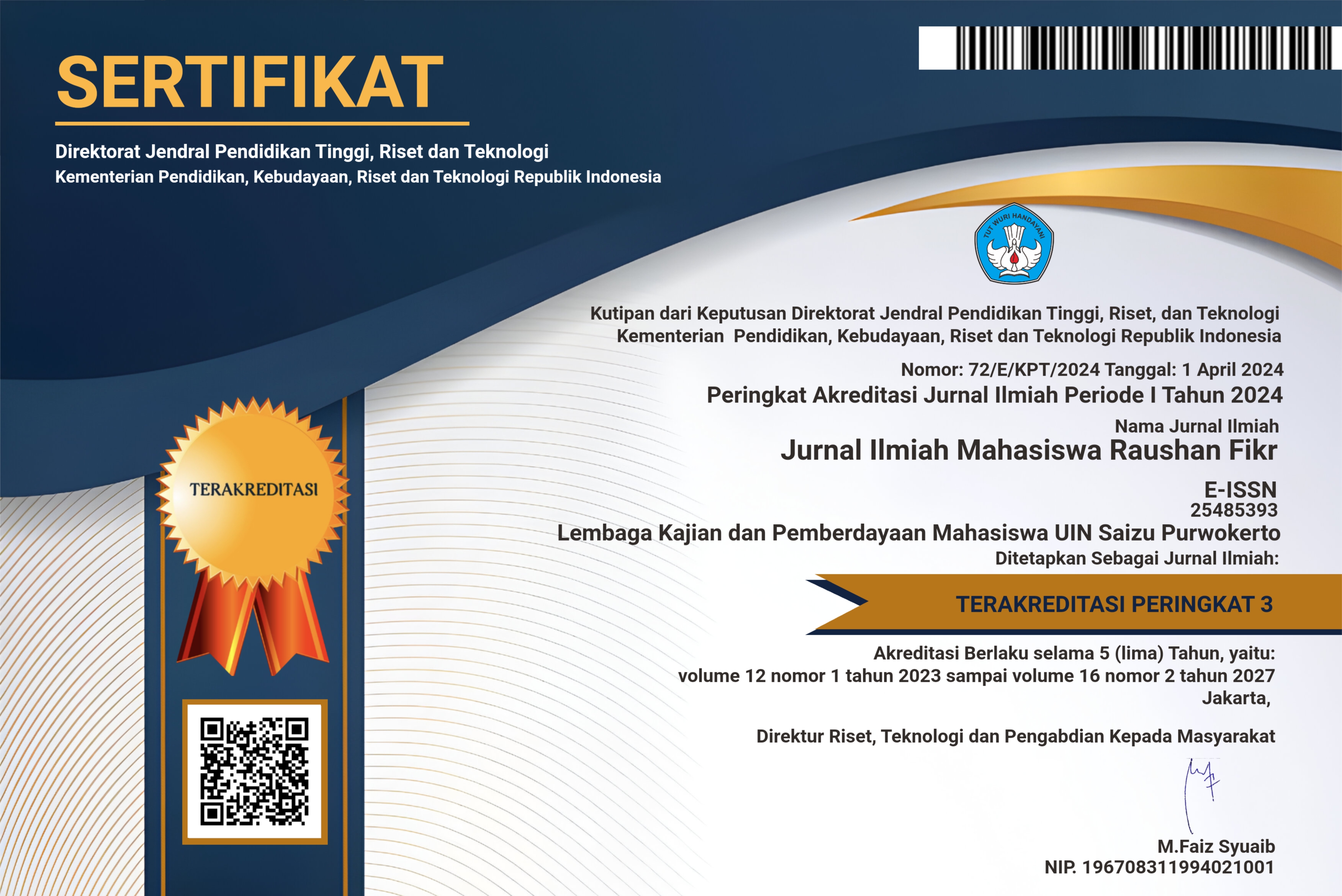Interpretasi dan Kontekstualisasi Kalimat Larangan dalam Alquran
DOI:
https://doi.org/10.24090/jimrf.v10i2.5064Keywords:
Interpretasi, Konteks, Qur'an, Kalimat LaranganAbstract
The aim of this article is to elaborate meaning, form, sense, and rules of nahy. The method used in collecting data is library method. Data analysis method used is content analysis method with elements of interpretation and description. In this article, the results are found based on reading of books contain meaning senses of prohibition sentence that nahy is leaving an act because it is forbidden from a higher side. While the form of prohibition or nahy is very diverse. Among various shigat or nahy forms, namely fi'il mudhari' which is preceded by la nahy, nafi, fi'il amr which indicates a prohibition, fi'il from the word nahy, and the statement using news sentence. In addition to meaning senses of nahy is prohibition, but sometimes the sense can change into: prayer, not permitted, degradation, guidance, persistence, exposition of consequence, expectation, menace, reprimand, consolation, and invitation. While the rules of nahy include: first, initial meaning sense of nahy is prohibition, instantaneous and lasting; secondly, when the form of prohibition is a matter that cannot be avoided, it contains semantics on nahy which is required to stay away; third, when there is a global prohibition, it applies to the whole; fourth, there is a prohibition in the form of news sentence; and fifth, nahy shows the damage.Downloads
References
al-Anshori, Abu Yahya Zakaria. 1520. Mulakhas Talkhis al-Miftah. Beirut: Daru Sodir.
_______________. Tt. Ghayatu al-Wusul Syarah Lubbu al-usul. Semarang: Karya Toha Putera.
Badruddin. 1989. al-Misbah fi al-Ma’ani wa al-Bayan wa al-Badi’. Mesir: al-Jamamizat,.
Hamka, Zainuddin. “Kaidah-kaidah Tafsir yang Berhubungan dengan Amr (Perintah) dan Nahy (Larangan) di dalam al-Qur’anâ€. Ash-Shahabah: Jurnal Pendidikan dan Islam. Vol 3 No. 2 Juli 2017.
Hamzah, Amir. “Kaidah-kaidah dalam Memahami al-Qur’an: Studi Tentang al-Amr dan an-Nahy dalam Penafsiran Ayat-ayat yang Mengandung Hukum dalam al-Quranâ€. Al-Qalam: Jurnal Kajian Islam & Pendidikan. Vol 8 No. 2 2016.
al-Hasyimi, Ahmad. 1960. Jawahirul Balaghah FI Al-Ma’ani Al-Bayan wa Al-Badi’. Surabaya: Maktabah Al-Hidayah.
al-Jarim, Ali & Amin, Musthafa. 1999. al-Balaghah al-Wadhihah: al-Bayan, al-Ma’ani, al-Badi’. Lundun: Daru al-Ma’arif.
Kaelan. 2012. Metode Penelitian Kualitatif Interdisipliner bidang sosiologi, Budaya, Filsafat, Seni, Agama, dan Humaniora. Yogyakarta: Paradigma.
Munawwir, Ahmad. 1997. W. Al-Munawir. Jakarta: Pustaka Praja.
ar-Razi, Fakhruddin. 1997. al-Mahshul Fi ‘Ilmi Ushul al-Fiqh. Beirut: Muassah ar-Risalah.
Ritonga, Muhammad Tohir. “Makna Amar dan Nahy dalam al-Qur‘anâ€. Al-I’jaz: Jurnal Kewahyuan Islam. Vol VI No. I Januari-Juni 2020.
Saepudin, Dindin Moch. 2019. Penerapan Kaidah La Nahyu pada Juz 30 Analisis Muhammad.
Said Khan, Musthafa. 1985. Atsarul Ikhtilaf Fi Al- Qawaid al-Ushuliyah Fi Ikhtikaf al-Fuqaha. Beirut: Muassash al-Risalah.
Syarifudin, Amir. 2001. Ushul Fiqh Jilid 2. Jakarta: Pt. Logos Wacana Ilmu.
as-Suyuti, Jalaluddin Abdurrahman. Tt. Syarah Uqudu al-Juman fi Ilmi al-Ma’ani wa al-bayani. Semarang: Karya Toha Putera.
at-Taftazani, Sa’duddin. 1937. Syarah al-Mukhtashar. Mesir: al-Mahmudiyyah at-Tijariyah.
Utsman, Khalib bin. 1421 H. Qawaid Tafsir Jam’an wa Dirasatan. Kairo: Dar ibn Utsman.
Downloads
Published
How to Cite
Issue
Section
License
Authors who publish with this journal agree to the following terms:
- Authors retain copyright and grant the journal right of first publication with the work simultaneously licensed under a Creative Commons Attribution-NonCommercial-ShareAlike 4.0 International License that allows others to share the work with an acknowledgement of the work's authorship and initial publication in this journal.
- Authors are able to enter into separate, additional contractual arrangements for the non-exclusive distribution of the journal's published version of the work (e.g., post it to an institutional repository or publish it in a book), with an acknowledgement of its initial publication in this journal.
- Authors are permitted and encouraged to post their work online (e.g., in institutional repositories or on their website) prior to and during the submission process, as it can lead to productive exchanges, as well as earlier and greater citation of published work (See The Effect of Open Access).
















